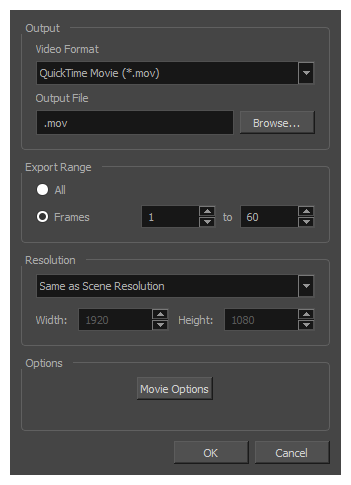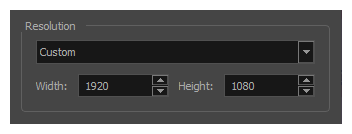T-HFND-010-013
Using the Export Movie dialog, you can export your animation as a video file. By default, Harmony will export your entire scene in its full resolution. If you prefer, you can choose to export only a specific frame range in your scene, or to export in a smaller resolution, which can be useful if you need to save on time or disk space. Depending on the format in which you export your movie, you can also customize the video and audio compression settings for quality or for disk space.
-
From the top menu, select File > Export > Movie.
The Export to QuickTime Movie dialog box opens.

- In the Output section, open the Video Format drop-down and select the desired format for your movie file:
QuickTime Movie (*.mov): The Apple QuickTime format. This is the default export format and is recommended for its portability, and also because it allows you to choose among several video codecs.
NOTES
- On Windows, Apple QuickTime must be installed to allow Harmony to export QuickTime movies. You can configure the export of QuickTime movies to use any codec that is compatible with QuickTime, including H.264, MPEG-4 and Animation.
- On macOS, Harmony uses Apple AVFoundation to export QuickTime movies, which allows you to export using codecs such as H.264, Apple ProRes 422 and Apple ProRes 4444, among others.
- If you are looking to export a QuickTime movie with transparency, be sure to choose a codec that supports encoding with an alpha channel.
H.264/MPEG-4 (*.mov) : A simple movie format that uses the H.264 codec, which is supported by most web browsers.
NOTES
- Using this format does not require additional software. However, if this is the first time you export a movie in H.264/MPEG-4 format, you will be prompted to download the OpenH264 library from Cisco. Simply click Yes when prompted, and Harmony will automatically download the library, then export the movie.
- There are no encoding options for this format.
- This format supports resolutions of up to 4096×2304. Each dimension must be a multiple of 16 pixels.
- Audio exported in this format is encoded in PCM 16-bit stereo, 22.05 kHz.
Windows Media Video (*.wmv): The native format for Windows Media Player.
NOTES
- Windows Media Video (.wmv) files can only be exported on Windows.
- Video players and editors on non-Windows systems can generally not open Windows Media Video (.wmv) files.
Flash (.swf)
Image sequence in Jpeg (.jpg), Targa (.tga) or Portable Network Graphics (.png) format.
- Click on the Browse button.
- In the Save dialog that appears, browse to the location where you want to export the movie file.
- In the File name field, type in the file name you want the movie file to have.
- Click on Save.
-
From the Export Range section, do one of the following:
- Select All if you want to render the entire scene.
- Select Frames if you want to render a part of your scene. Then, in the field to the right, type in the first frame of the sequence you want to export, and in the other field, the last frame of the sequence you want to render.

-
Open the Resolution drop-down and do one of the following:
-
Select Same as Scene Resolution if you want to export a movie with the same resolution as your scene.

-
Select 3/4 of Scene Resolution, 1/2 of Scene Resolution, 1/3 of Scene Resolution or 1/4 of Scene Resolution if you want to export a movie that is smaller than the resolution of your scene.

-
Select Custom if you want to manually set the export resolution. Then, in the Width and Height fields, type in the desired resolution for your movie, in pixels.

-
- In the Options section, click on Movie Options if you want to configure the video and audio compression settings for the movie to export.
NOTES
- For information on how to configure movie settings for a QuickTime Movie (.mov), see:
- For information on how to configure the movie settings when exporting in Windows Media Video (.wmv) format, see Configuring Movie Settings for Windows Media Video.
- When exporting in H.264/MPEG-4 (.mp4) format, there are no video and audio compression settings.
- If you are using GNU/Linux and are exporting in QuickTime Movie (.mov) format, there will be a button for the Video Options and one for the Sound Options.
- Click OK.
- In the Export to QuickTime Movie dialog box, click OK.
A progress bar appears.

- Browse to the location on your computer where you exported your movie file, and double-click on it to view it in your video player.